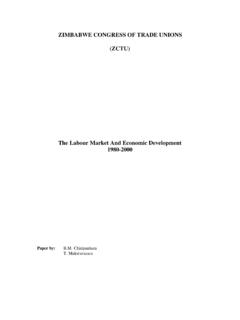Transcription of The role of small and medium enterprises in …
1 Theoretical and Applied Economics Volume XXI (2014), No. 1(590), pp. 87-102. The role of small and medium enterprises in improving employment and in the post-crisis resumption of economic growth in Romania Mirela Ionela ACELEANU. Bucharest University of Economic Studies Daniela Livia TRA C . Bucharest University of Economic Studies Andreea Claudia ERBAN. Bucharest University of Economic Studies Abstract. In the European Union, the Europe 2020 strategy seeks to obtain a smart, sustainable and inclusive economic growth that ensures high levels of employment , productivity and social cohesion. On the other hand, Europe 2020 strategy also supports the overcoming of the current economic crisis, which has caused and continues to cause effects in various sectors of the economy. In this context, the system of companies represents the "heart" of this strategy of growth of the European economy. Encouraging the SME sector is an important concern at European Union level, considering that SMEs are key drivers for economic recovery.
2 The paper focuses on SMEs because at European Union level they accounted for of total non-financial businesses. The crisis has highlighted the vulnerability of these enterprises , and of all the problems facing this system, we will focus on the one that targets the impact of the crisis on the active population of SMEs in Romania, compared with the European Union. Keywords: small and medium enterprises (SMEs), Europe 2020 strategy, economic crisis, employment , economic growth. JEL Classification: L26, G01, J24. REL Classification: 17H, 20I, 12G. 88 Mirela Ionela Aceleanu, Daniela Livia Tra c , Andreea Claudia erban 1. Introduction small and medium enterprises play an important role in the development of economy, by creating jobs, by supporting competitiveness and innovation, emphasizing dynamism and market atomicity. Both in Europe and in Romania, small and medium enterprises (SMEs) are predominant in both the total number of enterprises and in terms of number of employees.
3 Therefore SMEs directly affect employment and economic growth. In Romania, SMEs account for 70% of GDP, provide employment of of total employment in the private sector and generate of gross value added. However, SMEs in Romania also face some difficulties, exacerbated by the current financial and economic crisis, related to difficulties in obtaining capital or credit, decreased demand for goods and services in domestic and foreign market, increases in raw material and energy prices, high taxes, bureaucracy, low absorption of European funds. These difficulties have influenced SMEs' access to new technologies and innovation, stressing the differences between Romania and the developed countries. In order to support the development of SMEs, strategies and action programs have been adopted at European level, allowing a better exploitation of the growth and innovation potential of SMEs. Among them an important role is played by small Business Act (SBA), Europe 2020 Strategy, Entrepreneurship 2020.
4 2. The role of SMEs in the "Europe 2020" Strategy Europe 2020 Strategy aims to be a mechanism to coordinate social policies, employment , education, research and energy connected to the competence of national governments. On the other hand, Europe 2020 Strategy also supports overcoming the current economic crisis that has caused and continues to cause effects in various sectors of the economy affecting the number of jobs and employment policies. Industry and especially SMEs have been hit hard by the economic crisis and all sectors face the challenge driven by globalization and adaptation of their manufacturing processes and their products to a competitive and sustainable economy. SMEs play an important role in supporting economic growth and overcoming the crisis, because they have the largest share in all enterprises , at European level and they also contribute the most to the gross value added. The role of small and medium enterprises in improving employment 89. SMEs represent the largest creator of jobs, thereby increasing employment of active labour.
5 Therefore, at European Union level, SMEs receive special attention in European policies and strategies. Being an important job creator, SME sector may be under crisis conditions an unemployment generator as well, which amplifies the concerns of decision makers to support this sector, especially in times of crisis. Thus, at European Union level, the improvement of the business environment is aimed, especially of SMEs; supporting innovative SMEs, promoting the internationalization of SMEs; improving the access of SMEs to the single market, improving the access of SMEs to Intellectual Property Protection; facilitating SMEs' access to finance, supporting research and development within SMEs. (Europe 2020 Strategy). In the field of employment , Europe 2020 Strategy mainly aims achieving an employment rate of 75% for the population aged 20 to 64 years. At the same time it aims to achieve economic, social and territorial cohesion by empowering people through high levels of employment , investing in skills, fighting poverty and modernizing labour markets and training systems and social protection to help people anticipate and manage changes.
6 To support SMEs, to increase employment , efforts should be made both at European and national level. Therefore, policies supporting SMEs should be combined with employment and economic growth policies. The successful implementation of these strategies depends on the coordination of common policies of the EU and the national ones (structural and macroeconomic adjustment); ensuring coordination between the National Reform Programmes and Convergence National Programmes (Stability), monitoring achieved progress and identifying in real time congestion and adverse effects. The successful implementation Europe 2020 strategy in Romania involves the development of decisive action that is focused on several priorities, listed and explained below. (Aceleanu, 2011). a) improving the functioning of the labour market Given the persistent negative effects on the labour market, policies and their implementation should have an important role in constituting a means of correcting the current trends and preventing the potential adverse effects.
7 (Burghelea, Ene, Uzl u, 2013). In this regard, it should be aimed at reducing structural unemployment, the adoption of flexicurity policies, and strengthening labour market institutions. 90 Mirela Ionela Aceleanu, Daniela Livia Tra c , Andreea Claudia erban Structurally speaking, chronically high unemployment is a major loss of human capital that discourages workers and lead to their premature withdrawal from the labour market generating social exclusion. At the same time, the persistence of high rates of long-term unemployment creates their tendency to self-perpetuate, thus creating difficulties for the economy to recover economically (hysteresis effect). The most common structural causes of persistent long-term unemployment in the European Union are: mismatches between educational qualifications and skills provided by the education and training systems; low geographical mobility of the workforce; geographical mismatch between employment and vacancies; the existence of a high tax burden on low income combined with generous social assistance benefits for those who do not work, acting as a disincentive in looking for a job; the persistence of undeclared work because of high cost of social security contributions which the employer has to bear; as well as the disappearance of some sectors of the economy where there is skilled labour and the emergence of new sectors in which there are many vacancies as there is no qualified personnel.
8 Flexicurity policies are the best tool for modernizing labour markets. However, they must be adapted to the post-crisis context, to accelerate the pace of reform, to reduce labour market segmentation and to support equality between women and men. Labour market institutions need to be strengthened, to ensure that workers benefit from transitions between jobs, occupations, business sectors. Ensuring profitability of transitions is essential for offering workers the necessary security to accept and cope with mobility adequately. In terms of the coordinates above, Romania has made progress in terms of labour market performance, but it still must act by improving legislation, combating undeclared work, promoting equality between women and men. It should also be sought the facilitation of transition from unemployment to employment , by anticipating changes in the labour market and the implementation of active measures to improve the employment . b) Better labour training, learning and continuous vocational training The present context needs competent workforce able to contribute and adapt to the changes imposed by the new technologies, the requirements of sustainable development and achievement of knowledge economy.
9 The investment in education and training, anticipation of skills needs, compliance and guidance services are fundamental factors in increasing productivity and competitiveness, in accelerating economic growth and increasing employment . The role of small and medium enterprises in improving employment 91. Skills are the key to economic growth, productivity and prosperity and creating jobs. Lifelong learning is an important element to ensure good transition between jobs and occupations, and to avoid long-term unemployment, leading to loss of human capital. (Badea, Pociov li teanu, 2011). In order to develop tools for qualifications, Romania follows the finalization of the National Qualifications Framework and the Classification of Occupations. It also provides support for continuous training through courses and counseling. Promoting workforce adaptability to the new requirements of the labour market, to the current economic developments and technology development should be continued.
10 It is necessary to define and effectively implement an integrated model of education for the labour market. A thorough reform of the education system with the achievement of a coherent network of lifelong learning through various educational institutions and forms requires a joint effort of the state and the private sector to support the assumed changes. c) More diverse and powerful policies to promote the creation of new jobs while increasing the demand for labour It is not enough to ensure that people remain active, but to accumulate the necessary skills to get a job. Economic development must be based on economic growth generating employment . Conditions to create more jobs need to be done, including within societies that operate with high skills and business models based on intensive research and development. Selective reductions of non-wage labour costs or well targeted employment subsidies may be incentives for employers to recruit long-term unemployed and other workers who are removed from the labour market.











